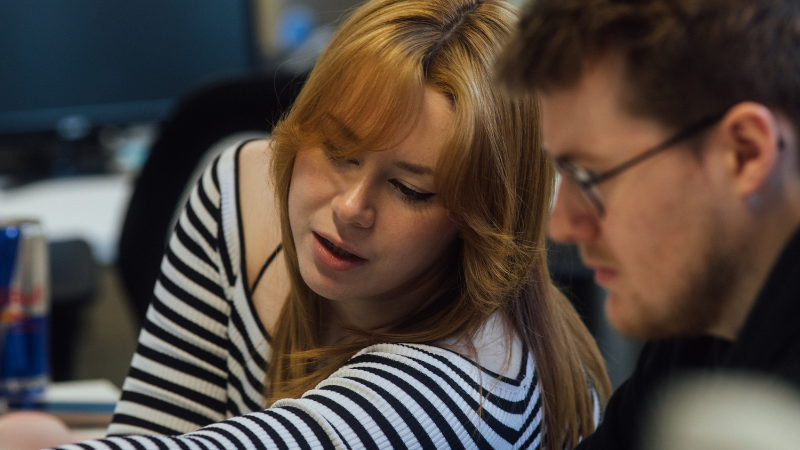The Conference.
On September 28th 2023, Yotel’s Imaginex Space in Edinburgh welcomed a mix of industry sectors and sizes for a day of learning, collaborating and networking at the Catalyst23 – Edinburgh’s only Innovation and Design Leadership Conference.
This year’s edition revolved around supporting guests on their journey to deliver commercial and cultural change through best-practice innovation and design. No sponsors. No sales pitches. The focus was on real-world innovation and design, with talks ranging from The Truth about Innovation in the Real World to Courageous Leadership, the theories of Strategic Foresight and Designing to Entertain.
Continuing with a recurring theme of last year’s Catalyst Conference, the event focused on minimising environmental impact. As well as insights from FNZ’s Head of Sustainability Dr. Vian Sharif which are discussed in this paper, the event also boosted its green credentials with its easily-accessible city-centre location, sustainably-sourced swag, extensive vegetarian menu options and removal of single-use plastic.
Read on to learn more about this year’s highlights spanning nature-centred design, navigating the innovation landscape, creating memories of the future, designing for a great viewing experience and leading with purpose. Whether you’re a UX Designer, business owner, team manager or just curious about how innovative technologies could better support your company’s mission and separate you from the competition – I’m certain you’ll come away inspired.
Nature-Centred Design: A Call to Action for Sustainable Business Practices.
In an era where the delicate balance between nature and corporate interests is more crucial than ever, Dr. Vian Sharif stands at the forefront of driving change. As the Head of Sustainability at FNZ, she is not merely a corporate figure but a pioneer in the quest for innovative technology solutions that catalyse the shift towards more sustainable capital allocations.
With over a decade of experience as a global asset manager at Investec and a significant role in various governmental and international sustainability advisory groups, Dr. Sharif is a force to be reckoned with in the realm of sustainable finance.
Nature’s Unprecedented Role
Dr. Sharif draws inspiration from the Netflix documentary “Virunga,” which serves as a poignant reminder of the profound interaction between nature and human activities.
She emphasises the duality of the corporate and natural realms, urging for alignment to avoid dismantling the ecosystem one block at a time, akin to a precarious Jenga tower.
Ecosystem Resilience at Risk
Highlighting the findings of the DASGUPTA Review 2020, Dr. Sharif underscores the fact that 100% of GDP is dependent on nature. The looming $90 trillion cost to transition to a truly sustainable economy is a stark reminder that big businesses must invest now to ensure their sustainability in the future.
The Taskforce on Nature Markets’ final recommendations – aiming for nature-positive and equitable outcomes – serve as a guidepost for businesses navigating this transformative journey.
From Compliance to Fiduciary Duty
Dr. Sharif advocates for a paradigm shift—from a ‘nice to have’ compliance approach to a hard-hitting commitment. It’s time for big businesses to consider nature as part of their balance sheet, measuring risks to nature and natural resources rather than focusing solely on return on investment.
She argues that protecting nature should be a fiduciary duty, with examples such as big pharma investing in the communities where they derive DNA and product IP.
It’s time for big businesses to consider nature as part of their balance sheet, measuring risks to nature and natural resources rather than focusing solely on return on investment.
The Winds of Change
Change is already underway, fueled by the influence of media, rapid digitisation and global initiatives like COP15 and the Global Biodiversity Framework.
Celebrities and actors are at the forefront, but big businesses must act now.
Dr. Sharif urges them to leverage the wealth of data in the public domain and measure the risk to nature and natural resources.
Shifting the Corporate Mindset
The shift towards a nature-led approach is not only a moral imperative but a strategic one. It attracts top talent from the younger generation entering large organisations, while early adopters are already reaping the benefits.
In financial services, innovations like Green Loans are making sustainability economically attractive. Small suppliers are pushing sustainability up the chain, compelling big businesses to comply.
In conclusion, Dr. Vian Sharif’s vision for nature-centred design is not just a call to action – it’s a blueprint for a more sustainable and resilient future. As big businesses grapple with the challenges and opportunities presented by the intersection of corporate and natural interests, they must heed the wisdom of leaders like Dr. Sharif to navigate these unprecedented times and shape a world where nature and commerce coexist harmoniously.

Navigating the Innovation Landscape: Insights from NatWest’s Innovation Delivery Leads.
In the ever-evolving landscape of financial services, innovation is not just a buzzword but a strategic imperative.
At NatWest Group, Ian Crawford and Dougie Pender are at the forefront, leading the charge in the Innovation Design and Delivery teams. Managing a talented team of circa 80 individuals, they are steering the ship within the Innovation & Partnerships department, creating novel solutions and products that redefine the banking experience.
Key Performance Indicators (KPIs) and Verticals
NatWest Digital operates with a clear focus on 3 crucial KPIs: Climate, Enterprise, and Learning. These pillars guide their efforts across 6 verticals: Strategy, Insight and Intel, Engagement and Partnerships, Future Products, Programs and Community, Strategic Investment and Innovation Portfolio.
Stages of Work
Their approach to innovation is methodical, following 5 distinct stages: Strategic Priorities, Explore and Define (utilising the Double Diamond methodology), Design and Test, Pilot and Build, and finally, Scale. Each stage is intricately linked to specific goals, ensuring a streamlined and effective innovation process.
Double Diamond Methodology
The Double Diamond methodology is employed to navigate through the stages of work, focusing on the Current, Potential, Intended and Improved situations. This structured approach allows for a comprehensive understanding of the challenges and opportunities at every turn, ultimately leading to refined solutions.
Project Examples
NatWest’s innovative endeavours include projects like Cora AI, facilitating 1.5 million conversations per month with an impressive 40% success/satisfaction rate; Carbon Planner, a free service aiding customers in sustainability actions; and Boxed, an online banking-as-a-service platform.
Innovation Truths
NatWest emphasises the importance of strategic thinking, careful governance and a well-defined strategy. They navigate the complex innovation landscape by being strategic, surveying the market landscape to avoid duplication, and maintaining a balance between innovation and governance.
They navigate the complex innovation landscape by being strategic, surveying the market landscape to avoid duplication, and maintaining a balance between innovation and governance.
Team Dynamics
The NatWest Digital team values a mix of creativity and resilience, recognising the importance of learning from their failures. Building a supportive community, rotating team members to foster creativity and actively seeking relationships with smaller suppliers are integral aspects of their approach.
AI Integration
For NatWest, AI isn’t just an option. It’s a core part of their innovation strategy. Leveraging tools like Outset.ai in the initial stages of research, they recognise that AI requires careful analysis, such as Jobs To Be Done (JTBD) to ensure its effectiveness.
Conclusion
NatWest’s innovation journey is marked by a commitment to strategy, a thoughtful approach to governance and a careful balance between creativity and resilience.
As they actively seek partnerships with smaller set-ups and dive head-first into the realm of AI, NatWest is not just adapting to change but driving it, setting a benchmark for innovation in the financial industry.

Strategic Foresight: Insights from Nathan Fulwood, Founder and Strategy Director at CreateFuture.
With a career rooted in the earliest days of the web, Nathan brings a wealth of experience in developing groundbreaking digital experiences for organisations such as the Press Association and Orange.
As one-third of CreateFuture’s founding team, Nathan has played a pivotal role in shaping the strategic direction of the agency and influencing the futures of notable clients, including adidas, Penguin Random House, NatWest and Royal London.
Unpacking VUCA: A Paradigm Shift in Management
Nathan’s thought leadership extends beyond the realm of traditional digital strategy. He opened a recent talk with an overview of Jan Oliver Schwarz’s VUCA ( which stands for volatility, uncertainty, complexity and ambiguity) Concept from Strategic Foresight: An Introductory Guide to Practice.
In a world where constant change is the new normal, Nathan urged the audience to abandon outdated approaches to management and embrace the challenges presented by VUCA. This shift demands a departure from conventional thinking and a willingness to navigate the uncharted territories of today’s business world.
This shift demands a departure from conventional thinking and a willingness to navigate the uncharted territories of today’s business world.
Strategic Foresight: Navigating the Unknown
In response to the VUCA environment, Nathan emphasised the importance of strategic foresight—a field that has emerged to help organisations make sense of the unpredictable and complex forces shaping their future. As the Strategy Director at CreateFuture, Nathan has been at the forefront of developing innovative approaches to address the challenges posed by VUCA.
Overcoming Cognitive Barriers
Nathan delved into the cognitive barriers that hinder effective strategy and innovation. These barriers include bias, groupthink, overconfidence and discomfort with ambiguity. CreateFuture’s approach involves guiding clients through four high-level approaches: perceiving, prospecting, probing and transforming.
The Evolution of Trends into Mega-Trends: A Hip-Hop-themed narrative
One standout moment from Nathan’s presentation was his unique visualisation of the life-cycle of trends evolving into mega-trends, using hip-hop as a metaphor. From the outliers and originators of early hip-hop in the 70s to the mainstream acceptance of the genre today, Nathan showcased how trends morph into mega-trends over time.
The journey from outlier and originator Kool Herc to the Sugar Hill Gang in the late ’70s, the Beastie Boys in the ’80s and into present-day norms like Ed Sheeran and his folk-hip-hop mash-up style illustrates the transformative power of cultural trends.
Rebel Ideas: Harnessing Cognitive Diversity
Nathan concluded this section with a powerful recommendation: “Rebel Ideas: The Power of Thinking Differently” by Matthew Syed. The book explores the concept of ‘cognitive diversity’—the ability to think differently about the world and harness unique perspectives to tackle challenges.
A Glimpse into the AI Near Future: “Agents” by Niantic
Closing his presentation on a thought-provoking note, Nathan showcased a poignant and slightly hard-hitting AI future scenario, “Agents” by Niantic. This glimpse into the future serves as a stark reminder of the rapid advancements in technology and their potential impact on our lives.

TV UX: Practical Insights from Neil Wardrop, Head of Product Design at YouView TV.
With a distinguished career that spans renowned organisations like BBC, Vodafone, Channel 4 and the Walt Disney Company, now Head of Product Design at YouView TV, Neil brings a wealth of experience in managing the product design process for high-volume, high-quality consumer experiences across web, mobile and TV.
A Journey through UX Evolution
Neil Wardrop recently captivated audiences at #Catalyst23 with a show-and-tell session, offering a unique perspective on the evolution of the YouView interface. Drawing on his extensive experience, Neil shed light on the considerations and influences that shape the user experience in a saturated marketplace of streaming services.
Beyond the Screen: Ergonomics and Environment
Coming from an Industrial Design background, I found Neil’s discussion particularly refreshing. He emphasised factors beyond the digital realm that influence our interactions with interfaces, notably ergonomics and environmental considerations. The evolution of the remote control, from a cluttered 80-button device to a sleek, tactile extension of the on-screen experience, exemplifies how product design can seamlessly integrate with human behaviour.
Neil introduced the concept of the “10ft environment,” representing the typical viewing distance for the majority of TV experiences. This environment, combined with the ergonomic design of the remote, creates a human-screen interactive experience so intuitive that it has become second nature to users of all demographics. As the saying goes, great design is often invisible, and Neil’s insights exemplify this principle.
Underlying Structures of Seamless Experiences
The YouView interface showcases invisible yet foundational structures that hold the user experience together.
These structures, such as sensible rails and rows of content, a digestible tone of voice, personalisation features, reduced clutter and the use of powerful imagery, contribute to a seamless and intuitive interface. These principles extend beyond TV interfaces and are commonly found in small-screen devices, apps and web products.
UX Best Practices: A Blend of Considerations
Neil’s session served as a masterclass in UX best practices, blending ergonomic, environmental, user experience and accessibility considerations. The session underscored the importance of holistic design that considers not just what appears on the screen but also how users physically interact with the interface and the context in which they do so.
Transferable Pointers for UX Success
Neil closed the session with two transferable pointers that apply to UX screen experiences at large: reduce user friction and get out of their way. These succinct principles capture the essence of a user-centric approach, emphasising simplicity and an unobtrusive user journey.
Neil Wardrop’s insights into the evolution of the YouView interface provide a comprehensive understanding of the intricate ecosystem of considerations that shape modern UX design.
…reduce user friction and get out of their way. These succinct principles capture the essence of a user-centric approach, emphasising simplicity and an unobtrusive user journey.

Leading with Purpose: Unveiling the Core Attributes of Future-Fit Leaders.
In the dynamic landscape of leadership, Joanna Howes, the CEO and Founder of The Change Creators, stands out as a beacon of wisdom, guiding leaders and teams towards their unique voices and unlocking the path to becoming high performers and future-fit leaders.
Let’s delve into the profound insights shared by Joanna, shedding light on the 4 common core attributes of future-fit leaders.
1. Decisive, Authentic, Vulnerable, Empower Others
Future-fit leaders embody 4 crucial attributes: decisiveness, authenticity, vulnerability and the ability to empower others. These traits form the foundation for effective leadership in an era demanding adaptability and genuine connection.
Empowering Others: The Stand-Out Behaviour
Empowering others emerges as the standout behaviour, where leaders ‘give power away’ through trust, coaching, celebration of success, autonomy, leading by example and investing in growth. This approach fosters a culture of collaboration and innovation.
This behaviour is backed-up by the ability to:
- Create trust through vulnerability
- Acknowledge weaknesses and stay authentic
- Allow others to know you personally
- Take responsibility in challenging times
- Practice empathy as a cornerstone of effective leadership
Self-awareness, Self-regulation, Authenticity
Future-fit leaders remain grounded by being self-aware, exercising self-regulation and staying true to their authentic selves. These principles serve as the guiding light through the complexities of leadership.
Future-fit leaders remain grounded by being self-aware, exercising self-regulation and staying true to their authentic selves. These principles serve as the guiding light through the complexities of leadership.

2. Personal and Self-Care: Building Good Habits
Joanna underscores the importance of personal well-being, emphasising the need for good habits in maintaining internal and external aspects of the self.
Internal Self Maintenance: Purpose, Values, Mindset, Beliefs
Leaders are encouraged to nurture their internal selves by aligning with their purpose and values, maintaining a growth mindset and fostering empowering beliefs.
External Self Maintenance: Job, Performance, Role Assets
Leadership extends beyond the self to encompass external factors such as job responsibilities, performance standards and the assets leaders bring to their roles.
Future Self Building: Continual Self-Maintenance and Growth
Building towards the future self requires ongoing self-maintenance, flushing out unnecessary elements, embracing change and fearlessly saying ‘yes’ to opportunities that align with personal growth.
3. High Performers vs. High Achievers
Joanna distinguishes between high performers and high achievers, shedding light on the critical differences that can lead to burnout.
High Performers: Empower, Trust, Stay Authentic
High performers exhibit positive behaviours, empowering others, trusting their teams, and remaining authentic. These leaders understand the importance of sustained self-care.
High Achievers: Beware of Burnout
While high achievers attain success, their focus on achievement alone can lead to burnout. Neglecting self-care and growth can hinder their journey from achievement to high performance.
Neglecting self-care and growth can hinder their journey from achievement to high performance.
4. From Doer to Leader: Embracing Courage
Joanna encourages leaders to transition from being mere “doers” to becoming courageous leaders. Trusting in resourcefulness and resilience is vital to avoid falling into the trap of achiever mode.
Closing Hints and Tips: Making Core Behaviours Habitual
Joanna leaves us with these valuable hints and tips:
- Regularly share expectations with your team
- Increase face-to-face interactions to break down remote working barriers
- Access a coach for ongoing support and guidance
- Explore “Radical Candor” by Kim Scott as a reference point
- Cultivate habitual behaviours for continued self-maintenance and growth
Joanna Howes’ insights serve as a compass for leaders navigating the complexities of the modern business landscape
As we embrace the future of leadership, the key lies in decisiveness, authenticity, vulnerability and empowering others—forging a path towards becoming future-fit leaders in every sense.
Conclusion.
This year’s Catalyst Conference focused on real-world innovation and design. How to create future products and services in complex and changing environments while growing and nurturing your teams (as well as yourself) to create the products and services of tomorrow.
To chat with us about how AI, innovation and human-centred design can be tailored to suit your needs and thoughtfully applied to your business strategy, get in touch.






